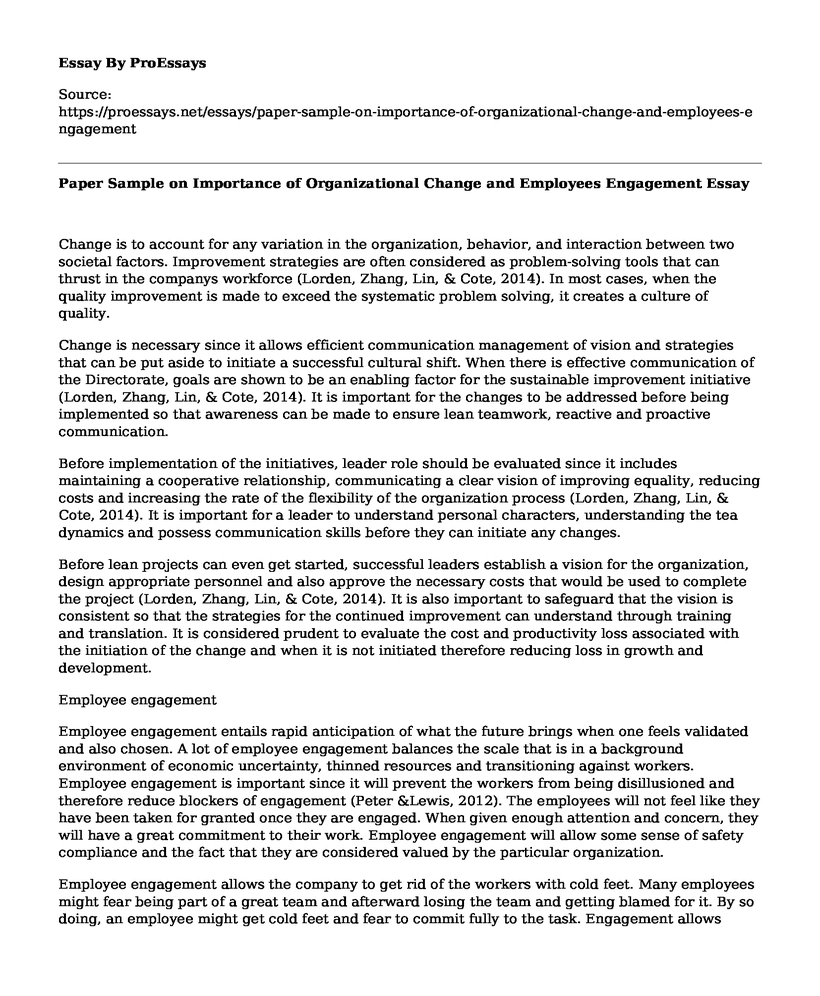Change is to account for any variation in the organization, behavior, and interaction between two societal factors. Improvement strategies are often considered as problem-solving tools that can thrust in the companys workforce (Lorden, Zhang, Lin, & Cote, 2014). In most cases, when the quality improvement is made to exceed the systematic problem solving, it creates a culture of quality.
Change is necessary since it allows efficient communication management of vision and strategies that can be put aside to initiate a successful cultural shift. When there is effective communication of the Directorate, goals are shown to be an enabling factor for the sustainable improvement initiative (Lorden, Zhang, Lin, & Cote, 2014). It is important for the changes to be addressed before being implemented so that awareness can be made to ensure lean teamwork, reactive and proactive communication.
Before implementation of the initiatives, leader role should be evaluated since it includes maintaining a cooperative relationship, communicating a clear vision of improving equality, reducing costs and increasing the rate of the flexibility of the organization process (Lorden, Zhang, Lin, & Cote, 2014). It is important for a leader to understand personal characters, understanding the tea dynamics and possess communication skills before they can initiate any changes.
Before lean projects can even get started, successful leaders establish a vision for the organization, design appropriate personnel and also approve the necessary costs that would be used to complete the project (Lorden, Zhang, Lin, & Cote, 2014). It is also important to safeguard that the vision is consistent so that the strategies for the continued improvement can understand through training and translation. It is considered prudent to evaluate the cost and productivity loss associated with the initiation of the change and when it is not initiated therefore reducing loss in growth and development.
Employee engagement
Employee engagement entails rapid anticipation of what the future brings when one feels validated and also chosen. A lot of employee engagement balances the scale that is in a background environment of economic uncertainty, thinned resources and transitioning against workers. Employee engagement is important since it will prevent the workers from being disillusioned and therefore reduce blockers of engagement (Peter &Lewis, 2012). The employees will not feel like they have been taken for granted once they are engaged. When given enough attention and concern, they will have a great commitment to their work. Employee engagement will allow some sense of safety compliance and the fact that they are considered valued by the particular organization.
Employee engagement allows the company to get rid of the workers with cold feet. Many employees might fear being part of a great team and afterward losing the team and getting blamed for it. By so doing, an employee might get cold feet and fear to commit fully to the task. Engagement allows employees to be united and not grow apart (Peter &Lewis, 2012). If employees learn the fact that leaders are less engaged in their safety, they might pull away and be apart.
Engaging the employees allows the culture of leadership to strengthen and by so doing, the companies can move at higher levels. Engagement should not be dismissed even at the thought of it being time-consuming (Peter &Lewis, 2012). Having a safe engagement workforce guarantees less risk, and it takes it into consideration to reduce the risk entirely while watching over the coworkers. Employee engagement supports safety changes in the organization.
A significant improvement can be obtained if only employee engagement is possible (Peter &Lewis, 2012). With the correct approach and method, the engagement would allow various companies to obtain the tremendous result in growth and production.
References
Lewis, R. P. (2012). Strategies for Leading engagement. Professional Safety, 1-5.
Lorden, A. L., Zhang, Y., Lin, S.-H., & Cote, M. J. (2014). Measure is of Success: The Role of Human Factors in Lean Implementation in Healthcare. The Quality Management Journal, 21(3), 26.
Cite this page
Paper Sample on Importance of Organizational Change and Employees Engagement. (2021, Apr 01). Retrieved from https://proessays.net/essays/paper-sample-on-importance-of-organizational-change-and-employees-engagement
If you are the original author of this essay and no longer wish to have it published on the ProEssays website, please click below to request its removal:
- Risks in the Banking Industry
- Recruiting and Selection in Apple Inc Paper Example
- Essay Sample on Significance of OSHA
- Effective Pre-departure Training Paper Example
- Essay Sample on A Trip That Changed My Career Path: From Business Admin to Nursing
- Essay Sample on Request Meeting With Mr. Dobbs & Mr. Stevens to Address Employee Concerns
- Paper Sample on Adapting to Change: Overcoming Challenges in the Business World







